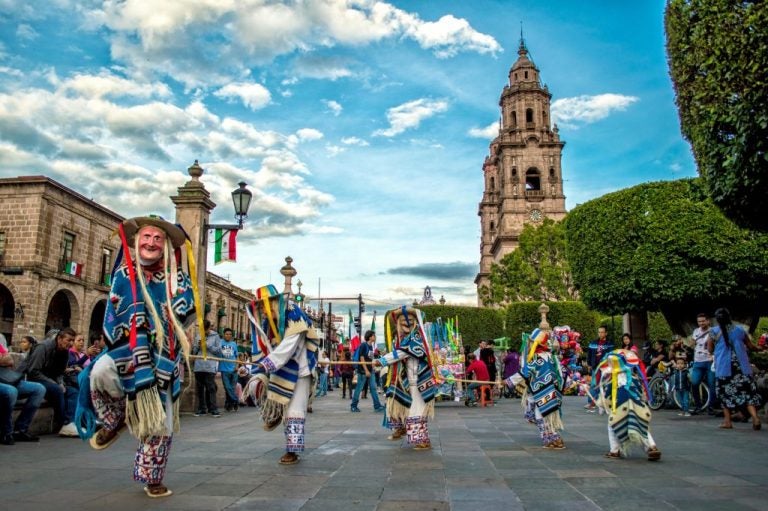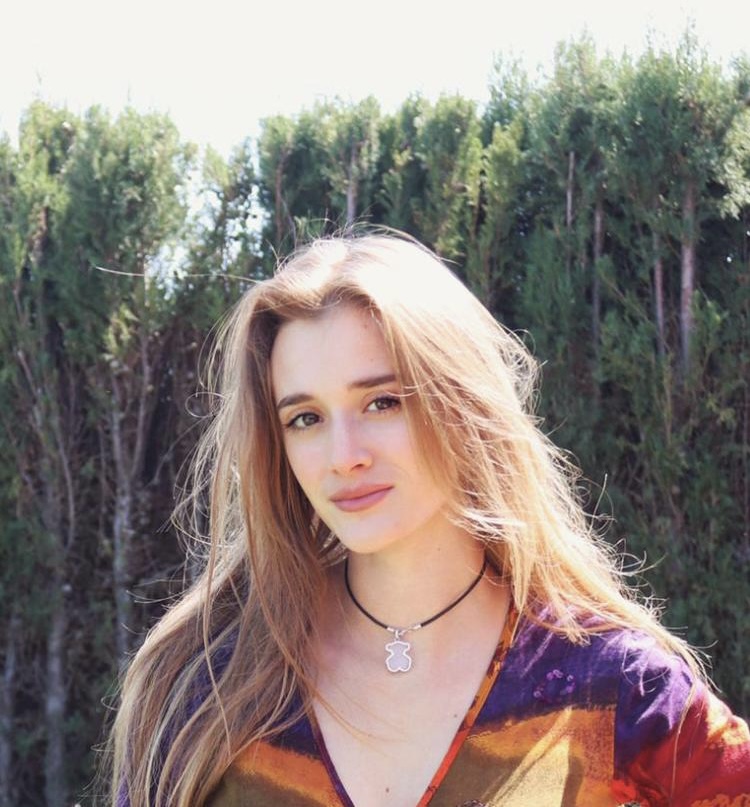Exploring Mexico as a Digital Nomad: Full Guide
Plan your stay as a digital nomad in Mexico. All about visa procedures, best cities to live, activities and cost of living.
Being a digital nomad in Mexico is an enriching experience that combines remote work with the opportunity to explore a country full of culture and natural beauty. If you are thinking about taking the leap and moving to this destination, here you will find relevant information that will help you prepare for your new experience. From visa requirements to the top cities for settling down, and a breakdown of the cost of living for digital nomads in Mexico, scroll down to uncover everything you need to know—Holafly has you covered!
Why choose Mexico to live as a digital nomad?

Mexico is a mix of modernity and tradition, with a rich culture and delicious cuisine. It is among the top ten best countries to work remotely in Latin America, according to Statista. Security and connectivity, which are important aspects for digital nomads, are good in Mexico. Additionally, Mexicans are accustomed to hosting large numbers of visitors, providing a warm and welcoming atmosphere that feels like home, especially during Mexican festivals.
The community of digital nomads in Mexico is growing, especially in cities like Mexico City, Playa del Carmen and Tulum. Due to the growing arrival of these travelers, these destinations offer shared workspaces and networking events, which has become a meeting point to meet other remote professionals.
Visas that allow you to reside as a digital nomad in Mexico
One of the key aspects to consider when planning your stay is the matter of visas. While there isn’t a specific digital nomad visa for Mexico at the moment, there are several alternative options worth exploring:
- Visitor visa: Allows stays of up to 180 days. Ideal if you plan to visit Mexico for a short period.
- Temporary residency visa: This is the most convenient option for digital nomads who wish to have a longer stay in Mexico. Unlike the visitor visa, it offers a stay of one to three years.
The temporary residence visa allows nomads to work remotely in their own businesses or for foreign companies without the pressure of having to leave the country, with the possibility of renewing the stay.
After four years of residing in the country on a temporary stay visa, you can choose to apply for permanent residency.
With the temporary residency visa, a digital nomad in Mexico can also access services such as opening bank accounts, contracting health insurance and other services that may require a specific immigration status.
Learn about the requirements and documents needed for each type of visa by consulting the official Mexican government sites on digital nomad visas in Mexico.
Important: If you are a frequent traveler and want to stay connected without worrying about expensive roaming or looking for a new SIM at every destination, Holafly’s subscription plans are for you. With a single eSIM, enjoy internet in more than 170 countries for a fixed price and no surprises on your bill. travel without limits and connect easily and securely! 🚀🌍

Best cities to live as a digital nomad in Mexico
Mexico has cities with environments that match the lifestyle of a digital nomad to work and enjoy life. Each city has its own charm and unique advantages, adapting to the different needs of travelers.
Mexico City (CDMX)
The Mexican capital is one of the largest metropolises in the world. Here, digital nomads will find a wide variety of coworking spaces, such as WeWork and Impact Hub that are popular for good connectivity, lounge areas and networking events that allow remote professionals to connect.
The cultural offerings are vast; the city is packed with museums, galleries and a dynamic nightlife. The cost of living in CDMX is affordable, with rents for one-bedroom apartments in the center ranging from 500 to 700 dollars a month, and food prices in restaurants are reasonable.

Playa del Carmen
This destination has become a favorite for those seeking a more relaxed lifestyle and an active community of digital nomads.
With a coastal atmosphere and pleasant climate, this city offers numerous coworking options, such as Selina and Nest, where prices range from 25 to 60 dollars a month.
The digital nomad community is welcoming, with regular events that encourage networking and socializing.
In terms of accommodation, you can find one-bedroom apartments from 400 dollars a month, and many opt for colivings that combine work and social life, allowing them to meet other professionals.
Tulum
Tulum has a natural beauty and a bohemian atmosphere. Although the costs may be a little higher, the experience it offers is unique. Here, nomads can enjoy a quieter lifestyle, surrounded by beaches and Mayan ruins.
Rents in Tulum are higher, with one-bedroom apartments ranging from 600 to 1,000 dollars, but many feel that the quality of life and natural surroundings justify the investment.

Accommodation options for digital nomads in Mexico
- Colivings: Spaces such as Selina and Outsite offer shared or private rooms, with access to workspaces and community activities. Prices can range from 300 to 600 dollars depending on location and amenities.
- Airbnb and exchange houses: If you prefer a more private place, Airbnb is an excellent option, with prices varying according to season and location. Exchange houses are an interesting alternative for extended stays.
If you’re unsure about what features a digital nomad accommodation should have, visit our article on how to find an ideal accommodation for a digital nomad.
Coworking spaces
Coworking spaces are essential for maintaining productivity. Here are some popular ones.
- WeWork: Has several locations in the CDMX, offering a wide range of services and environments. Prices start at 40 dollars.
- Selina: Popular in Playa del Carmen and Tulum, offers an exotic environment for networking events and prices start at 25 dollars.
- Casa Búho: In Tulum, it’s known for its unique design and relaxed atmosphere, with prices starting at 40 dollars.

Internet connection for digital nomads in Mexico
The quality of the internet in Mexico has improved significantly in recent years, becoming a fundamental aspect for digital nomads who depend on a stable connection to work.
In general, urban areas, especially large cities such as Mexico City, Playa del Carmen and Tulum, have adequate infrastructure that offers good quality connections.
- Cafés: An excellent option for those looking for a place to work and socialize. Establishments such as Café de Tacuba in Mexico City and Café Muro in Playa del Carmen are very popular among digital nomads. These places have a comfortable and cozy atmosphere and free Wi-Fi and good connection speed.
- Libraries and public spaces: In Mexico City, the Vasconcelos Library is a standout for its architectural design and excellent connectivity.
In Tulum, several parks and community centers, such as Parque dos aguas, have free Wi-Fi, allowing nomads to work outdoors while enjoying the natural surroundings.
It is important to note that while internet quality is generally good, there are some more rural or less developed areas where connection may be limited.
At Holafly, we offer unlimited data in over 200 destinations, including Mexico! Purchase the best eSIM for Mexico and enjoy our fast and secure connection services wherever you go.

What taxes does a digital nomad pay in Mexico?
As a digital nomad in Mexico, it is important to understand the tax responsibilities to which you must respond. Mexican tax law states that, if you reside more than 183 days a year in the country, you may be subject to local taxes including:
- ISR (Income Tax): Applies to income generated in Mexico.
- VAT (Value Added Tax): Generally 16% on goods and services.
Mexico has double taxation treaties with several countries, which can help you avoid double taxation. For specific details on taxation, see our article Taxes for digital nomads in Mexico.
Insurance and medical services for a digital nomad in Mexico
Access to health
Access to healthcare in Mexico is diverse and flexible, allowing digital nomads to choose between the public and private healthcare systems. Although the public system, known as IMSS (Instituto Mexicano del Seguro Social), provides medical care to residents and workers, many nomads prefer to opt for private health insurance because of the speed and quality of care they offer.
Private health insurance provides access to clinics and hospitals with better facilities and shorter waiting times. Recommended options include:
- World Nomads: This insurance is ideal for travelers seeking comprehensive coverage, including emergency medical care and adventure activities. Prices start at around 100 dollars per month, depending on the coverage chosen.
- SafetyWing: Designed for digital nomads, it offers medical coverage and other useful benefits, such as equipment and liability insurance. Rates start at about 40 dollars a month, making it affordable for many.
It is essential to review the conditions of each policy, as some may have limitations in terms of coverage for pre-existing conditions or certain specialties. For more information on health insurance for digital nomads in Mexico, and their coverage in this country, visit the official websites that we recommend.
Quality of medical service
The quality of medical care in Mexico is good, especially in urban areas. Major cities have a wide range of both public and private clinics and hospitals. Medical care in the private sector is known for its efficiency, advanced technology, and 24/7 care.
Basic expenses that every digital nomad in Mexico should know about
Transportation and mobility
Mexico presents a variety of accessible and efficient options. Public transportation is a common and economical way to get around.
In cities like Mexico City, the metro is one of the fastest ways to get around, with a fare of approximately 0.25 cents per trip, making it a very affordable option. Buses are also inexpensive, with fares ranging from 0.50 to 1 dollar, depending on the distance.
Cabs and car-sharing services such as Uber and Didi are widely used and safe. Uber fares in CDMX usually start at around 3 dollars per ride, depending on the distance.
If you plan to drive, you can use your foreign license in Mexico, as long as it is valid. For longer stays, it is advisable to obtain an international permit.
You can check the international permit requirements on the website of the Mexican Ministry of Mobility (SEMOVI).
Managing finances of a digital nomad in Mexico
Recommended banks
HSBC Mexico, has a good presence in the country and offers accounts in both pesos and dollars. This facilitates the management of your expenses and savings, without the need to incur additional costs for currency conversion.
Digital banks
Nubank is gaining popularity, especially among young people and nomads, for its ease of use and low fees.
You can withdraw cash with the Nu card at any ATM that accepts MasterCard and at supermarkets such as Walmart, but we recommend you make your transactions at the ATMs of Inbursa and Banjercito banks, which currently charge the lowest percentage of commission, between 15 to 16 Mexican pesos, or less than a dollar.
Food expenses in Mexico
In Mexico, you can enjoy a wide gastronomic menu, local markets and supermarket chains such as Soriana and Walmart, where you can find fresh produce at good prices.
In local markets, such as the Mercado de San Juan in Mexico City, you can find exotic fruits, artisanal cheeses and other regional products.
The average cost of a meal at an average restaurant ranges from 10 to 30 dollars, but you can also find cheaper options at taquerias and street food stands, where a taco can cost less than two dollars.

Entertainment experiences for digital nomads in Mexico
The variety of fun activities adapts to all tastes. If you like water sports, you can enjoy activities such as surfing and snorkeling in coastal destinations like Playa del Carmen and Tulum.
For those interested in culture, events such as the Day of the Dead and the International Book Fair in Guadalajara are not to be missed. You can also explore archaeological sites such as Chichen Itza or Teotihuacan, which offer a deep connection to Mexican history.
For more relaxed entertainment, don’t miss the local plazas and parks, where there is often live music and art exhibits.
Best seasons to visit Mexico as a digital nomad

The climate in Mexico varies by region, but in general, the months of November through April are the best months to visit, especially in places like Cancun, Tulum and Mexico City.
During these months, the weather is cooler and drier, allowing you to enjoy outdoor activities without the intense summer heat. We suggest you bring light clothing, but also a sweater or jacket for cool nights, as well as essentials such as sunscreen and insect repellent.
If you’re planning to enjoy the coast, consider visiting during the off-season (May to October) when you’ll encounter fewer tourists and better rates on accommodations.
Cost of living as a digital nomad in Mexico
Costs can vary significantly depending on the city and lifestyle. Here is an estimated breakdown of the average costs that you should take into account and include in your planning for your stay in Mexico. Evaluating these aspects and costs in advance will help you adjust your travel budget according to your needs.
| Category | Description | Average cost in dollars |
| Accommodation | Colivings, apartments and Airbnb in popular cities. | 300-1,500 dollars (monthly) |
| Coworking spaces | Access to shared workplaces in cities such as Mexico City and Playa del Carmen. | 15-75 dollars (daily), 300-1,500 dollars (monthly) |
| Food | Meals in restaurants, local markets and supermarkets. | – Restaurant: 10 to 30 dollars. – Taquerias or street food: less than 2 dollars. |
| Transportation | Metro, buses and cab applications. | – Cost of public transportation: less than 1 dollar per trip. – Car sharing service (Uber, Didi). From 3 dollars (per trip) |
| Medical insurance | Medical coverage through international insurance. | 40-100 dollars (monthly) |
| Entertainment | Cultural activities, festivals and water sports. | Varies according to the activity from five to 50 dollars. |
| TOTAL LIVING COSTS | Estimated total monthly cost as a digital nomad in Mexico, including accommodation, food, transportation and leisure. | 1,200-2,500 dollars |
Frequently asked questions about being a digital nomad in Mexico
Yes, it is recommended to get a temporary visa if you plan to stay more than 180 days. The digital nomad visa does not exist yet, but the temporary visa is a convenient option.
Safety varies by region. Big cities like Mexico City and Playa del Carmen have safe areas, but it is always advisable to inform yourself about the areas and take precautions.
In general, internet quality is good in urban areas, with multiple options of cafes and coworking spaces offering high-speed Wi-Fi. Remember that with Holafly’s unlimited data eSIM you can have a fast and secure connection wherever you go.
The average cost can vary between 1,200 and 2,500 dollars, depending on the city and lifestyle, including accommodation, food, and entertainment.
International health insurances such as World Nomads or SafetyWing are recommended, with prices ranging from 40 to 100 dollars per month, depending on the coverage.
The most popular cities include Mexico City, Playa del Carmen, and Tulum, each offering different environments and nomad communities.





 Language
Language 


















 No results found
No results found









